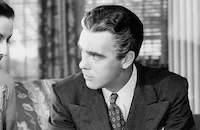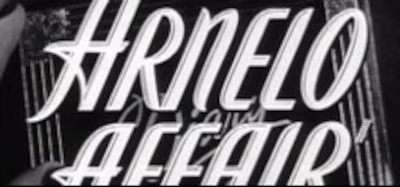The Arnelo Affair

Brief Synopsis
Cast & Crew
Arch Oboler
John Hodiak
George Murphy
Frances Gifford
Dean Stockwell
Eve Arden
Film Details
Technical Specs

Synopsis
While driving down a street in Chicago, Tony Arnelo, a crooked nightclub owner, tells his mistress, Anne Parkson, that he killed his former girl friend, the actress Claire Lorrison. Tony claims that he killed Claire in order to be with Anne, and warns Anne that he will implicate her in the murder if she goes to the police. Regretting her association with Tony, Anne thinks back to the day her husband Ted, a lawyer, introduced her to Tony, a new client: Tony is immediately smitten with Anne, and Anne, neglected by her overworked husband, allows herself to fall instantly in love with him. Though torn between her devotion to her family and her attraction to Tony, Anne eventually consents to meet Tony in secret at his apartment. After Tony hires Anne to be the interior decorator at his nightclub, a furtive affair develops. Anne, however, begins to feel guilty, and tries to repair her marriage by asking her husband to take her on a long trip. When Ted refuses to leave town, citing his heavy work load, Anne decides to pursue her affair with greater resolve. Anne's infatuation with Tony soon ends, though, when she finds Claire at Tony's apartment, and when Claire tells her that Tony mistreated her. Tony, overhearing the accusation, slaps Claire, and Anne leaves in haste. The following day, Anne is shocked by a newspaper story announcing that Claire has been murdered, and that a compact case bearing the initial "A" was found in her possession. As Anne comes out of her reverie, Tony warns her of the dire consequences she faces if she tells anyone what she knows about the murder, and insists that they continue their affair. At a stoplight, Anne jumps out of Tony's car and runs home. The next day, on Ted and Anne's twelfth wedding anniversary, Ted surprises Anne by taking her to Tony's nightclub for dinner with their friends. The dinner is interrupted by a visit from homicide detective Sam Leonard, who asks Tony about Claire. Tony coolly denies any association with the actress, but Anne faints, unable to bear the questioning and innuendoes. Later, Ted finds Anne's key to Tony's apartment and realizes that his wife has been having an affair with Tony. He also discovers that the police suspect that Anne is involved in Claire's murder when Leonard shows him Anne's compact case. When Ted confronts Tony with his knowledge of the affair and demands to know the truth about Claire's murder, Tony lies to him and tells him that Anne killed Claire. Refusing to believe Tony's story, Ted begins his own investigation into the murder and discovers that Anne could not have killed Claire because she was with him at the time of the murder. Leonard eventually arrests Tony for the murder, but when Tony tries to escape, the detective shoots him. With his dying breath, Tony confesses his guilt, and Anne is exonerated. Ted returns home to find that Anne has made an unsuccessful attempt to kill herself with an overdose of pills. Anne soon recovers, and after Ted forgives her, they embrace.

Director
Arch Oboler
Cast

John Hodiak

George Murphy

Frances Gifford

Dean Stockwell

Eve Arden

Warner Anderson

Lowell Gilmore
Michael Branden
Ruth Brady
Ruby Dandridge

Joan Woodbury

Griff Barnett
Constance Weiler
Barbara Billingsley
George Carleton
Frank Wilcox

Lillian Bronson
James Carlisle
Wyndham Standing
Bill Shaw
Shimen Ruskin
Milton Kibbee
Thaddeus Jones
Ed Max
Ellen Rose
Erin O'kelly
Nolan Leary
Crew
George Bassman
Jerry Bresler
Jack Dawn
Cedric Gibbons
Bert Glazer
Charles Hunt
Irene
Harry Komer
Don Mcdougall
Arch Oboler
Wade Rubottom
Charles Salerno
Robert Shannon
Douglas Shearer
Thomas Theuerkauf
Edwin B. Willis

Film Details
Technical Specs

Articles
The Arnelo Affair -
John Hodiak came to the world's attention three years earlier but his journey to that moment of instant stardom was as unlikely as it was hard fought. Hodiak began acting as a small boy but when he tried out for acting work on the radio, he didn't make the cut. His working class Pennsylvania accent wasn't what they were looking for and Hodiak took odd jobs while working on correcting the problem. After developing a more neutral "radio voice" he landed work and, after his service in World War II, managed to sign on with not just any movie studio, but the biggest movie studio of them all, MGM. Even with a studio as big as MGM, however, Hodiak wasn't willing to compromise on his name and despite the studio chiefs wanting a catchier, more "American" sounding name, Hodiak, the proud son of Ukrainian and Polish immigrants, refused. He kept the name and within a year, found himself loaned out to 20th Century Fox to work with one of the biggest names in film then or now, Alfred Hitchcock. The movie was Lifeboat and with its release in 1944, Hodiak became a star.
Stardom doesn't always go like it's supposed to, unfortunately. Hodiak's career had some interesting and successful films but all too many were disappointments. Two of his biggest, after Lifeboat, were A Bell for Adano (1945) and Battleground (1949). Most of the time, though, he worked in smaller, low budget environments and sometimes the work paid off. The Arnelo Affair was one such case.
The Arnelo Affair works thanks to an interesting premise, a good director, two interesting leads, and two great supporting players. Its director, Arch Oboler, was a playwright as well and brought his considerable talents to bear. Despite his many anti-fascist plays of the thirties and his extensive work on the radio, he is perhaps best known as the man who directed the first ever 3-D film, Bwana Devil (1952).
The two interesting leads, Hodiak and Frances Gifford, work well together and create a personal tension between each other far more interesting than anything going on with Gifford's husband, played rather ineffectively by George Murphy. Hodiak is just menacing enough, and Gifford just vulnerable enough, to make the chemistry work.
The two great supporting players come in the form of Eve Arden and Warner Anderson. Arden is Gifford's best friend and Anderson is the detective investigating the case. As good as the leads are, when these two are on the screen the movie belongs to them.
John Hodiak may have had a much more fulfilling career once he aged a bit more and transitioned into older roles but, sadly, he was struck down by a heart attack at the young age of 41. At that point he had seen his star fade (he played the role of Lieutenant Maryk on Broadway in The Caine Mutiny only to see the role go to Van Johnson for the film adaptation) but hoped for better work. His best films were behind him but better ones may have laid ahead. The Arnelo Affair isn't as well known as Lifeboat or A Bell for Adano but it features fine work by Hodiak, Gifford, Arden, and Anderson (including a small role by a very young Dean Stockwell) and ranks as one of the better low budget noirs from the period.
Producers: Jerry Bresler Director: Arch Oboler Writers: Jane Burr (story), Arch Oboler Original Music: George Bassman Cinematography: Charles Salerno, Jr Film Editing: Harry Komer Art Direction: Cedric Gibbons, Wade Rubottom Costume Design: Irene Cast: John Hodiak (Tony Arnelo), George Murphy (Theodore 'Ted' Parkson), Frances Gifford (Anne Parkson), Dean Stockwell (Ricky Parkson), Eve Arden (Vivian Delwyn), Warner Anderson (Det. Sam Leonard), Lowell Gilmore (Dr. Avery Border), Archie Twitchell (Roger Alison), Ruth Brady (Dorothy Alison), Ruby Dandridge (Maybelle - Parkson's Maid), Joan Woodbury (Claire Lorrison)
By Greg Ferrara

The Arnelo Affair -
Quotes
Trivia
Notes
A mid-June Hollywood Reporter news item noted that director Arch Oboler conducted research on the film in Chicago, and that he shot backgound footage in Chicago's Wacker Drive sector. The film marked producer Jerry Bresler's final film for M-G-M.















